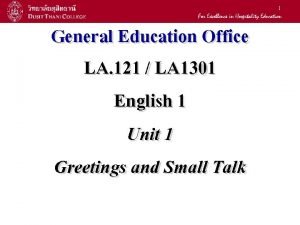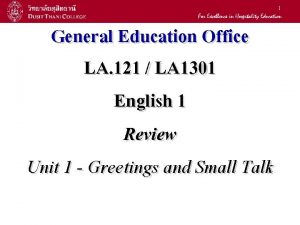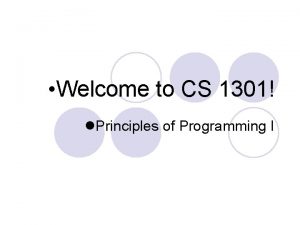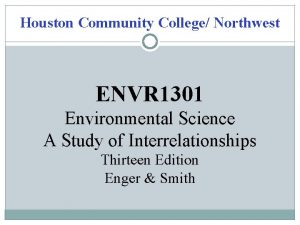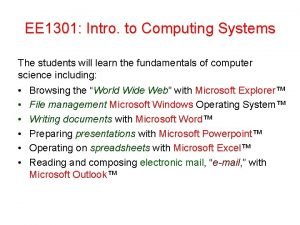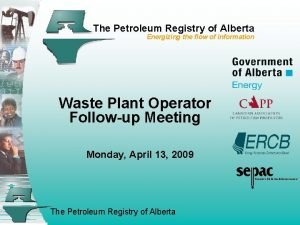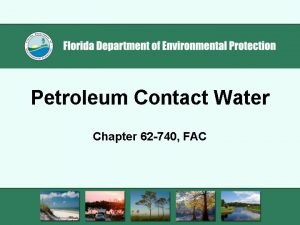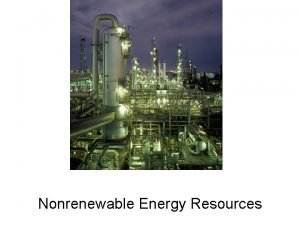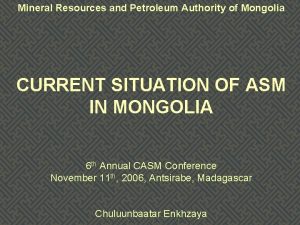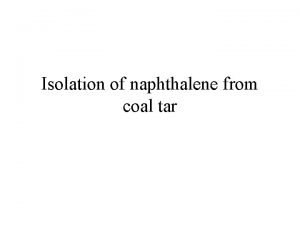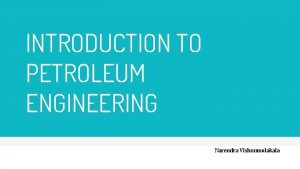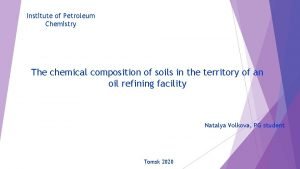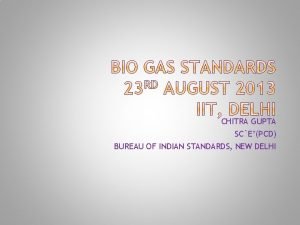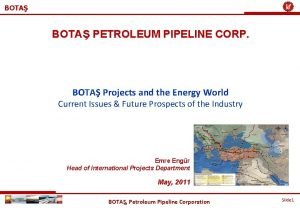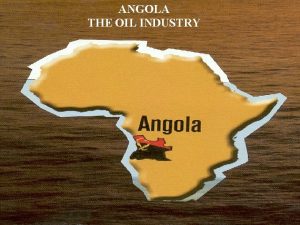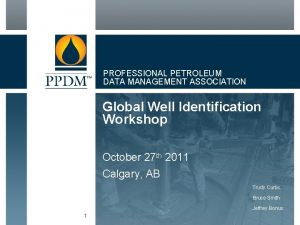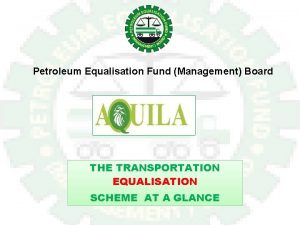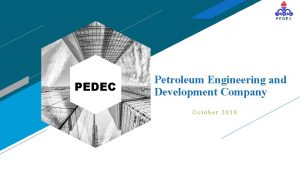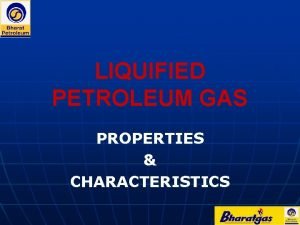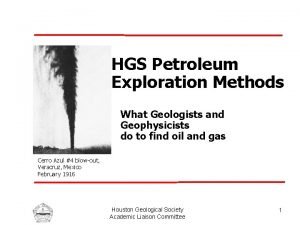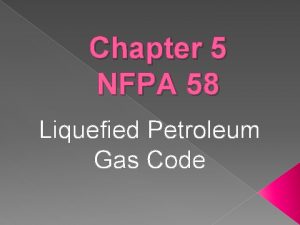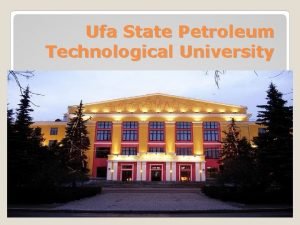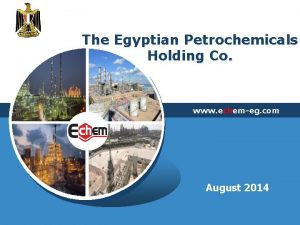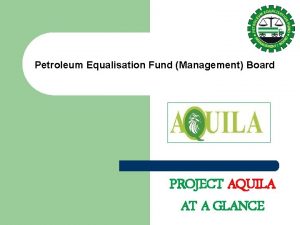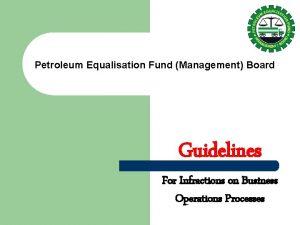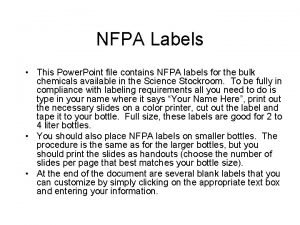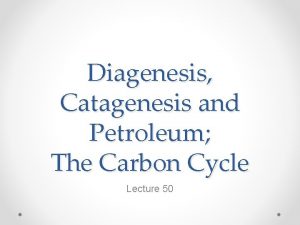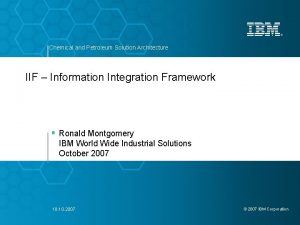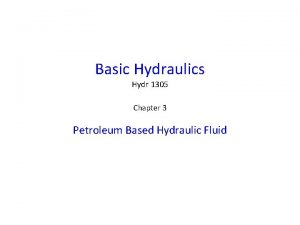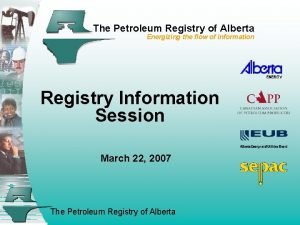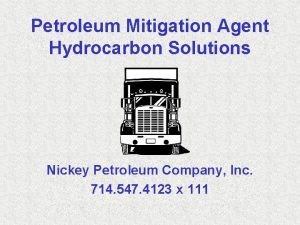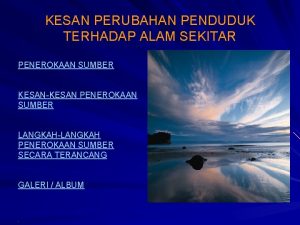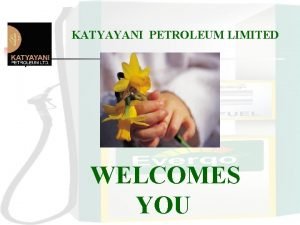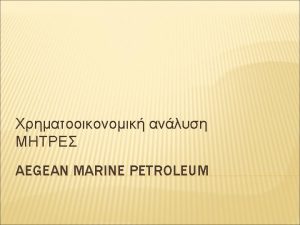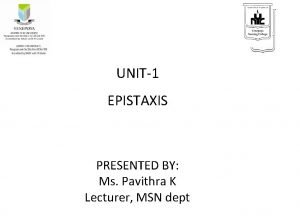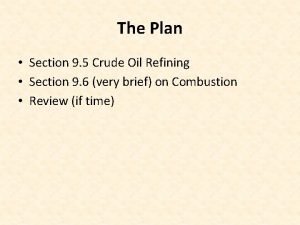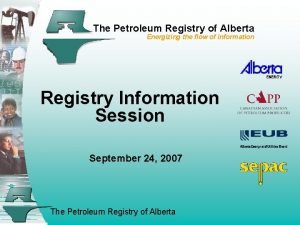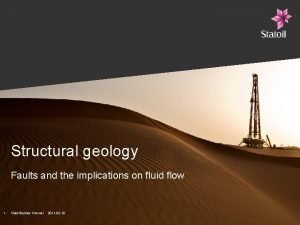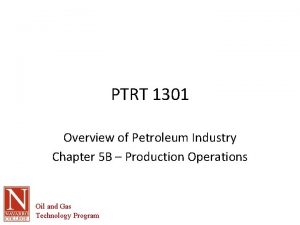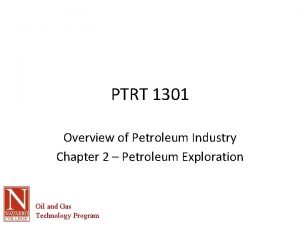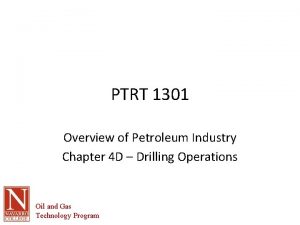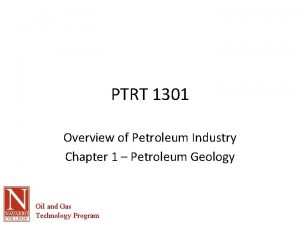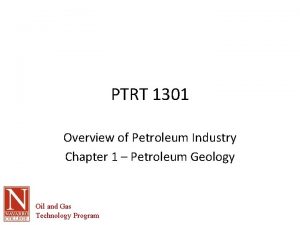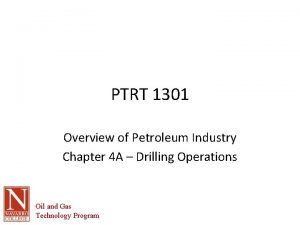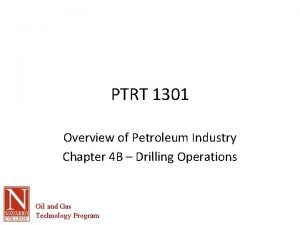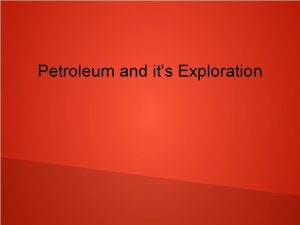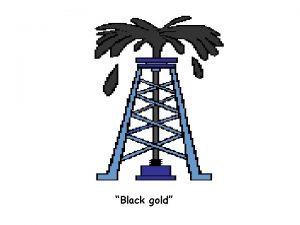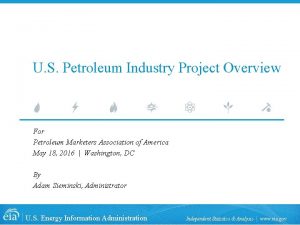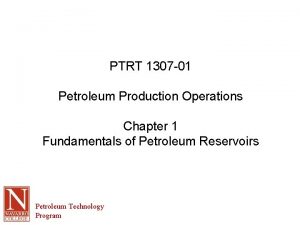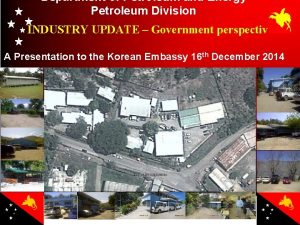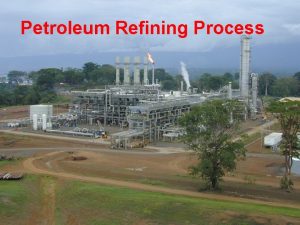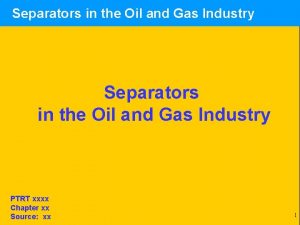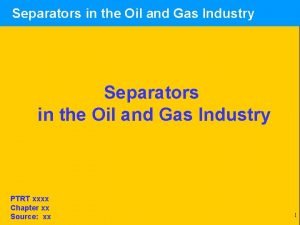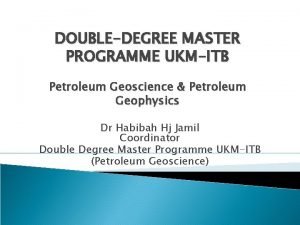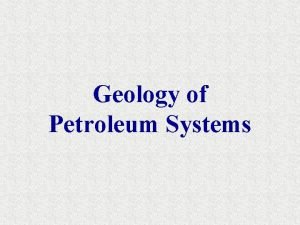PTRT 1301 Overview of Petroleum Industry Chapter 5





















































- Slides: 53

PTRT 1301 Overview of Petroleum Industry Chapter 5 A – Production Operations Oil and Gas Technology Program

Well Completion • Well completion as early as 1000 BC • Modern completion techniques began in 1808 in saltwater wells – Casing – used to seal off upper (less concentrated brine) from lower zones (more concentrated brine) – Pumping – walking beam used to drive a reciprocating pump (rod pumps) – ESP and gas lift pumps followed rapidly • Storage and handling (bbl = 42 gallons) – Surface equipment to separate gas/oil/water Oil and Gas Technology Program

Production Casing and Liners • As many as 4 different concentric strings of pipe will often be used in a completed well each one reaching the surface – – Conductor casing Surface casing Intermediate casing Production casing (oil or long string) • In deeper wells a liner may take the place of the production casing – Does not extend to the surface – Hangs from a liner hanger – Lower cost • Casing is cemented into place after it is set Oil and Gas Technology Program

Oil and Gas Technology Program

Types of Completion • Open hole (barefoot) • Reservoir fluids flow unrestricted into the well • Many disadvantages – Sloughing – Sand production – Lack of flow control Oil and Gas Technology Program

Perforated Completion • Casing extends to the bottom of the well • Gun (shaped explosive charges) used to pierce the casing – Shaped charges – Jet perforating Oil and Gas Technology Program

Perforating • Majority of Safety accidents occur on the surface • Normally the result of not disabling the charges on the surface after a misfire down hole • API document RP-67 describes recommended safety practices for handling perforating guns Oil and Gas Technology Program

Wire-wrapped Screen Completion • Control sand production in unconsolidated formations • Screen installs at bottom of tubing • Gravel pack or resin pack outside the screen Oil and Gas Technology Program

Oil and Gas Technology Program

Tubing • Typical completion configuration • Production Tubing – Final string of pipe – Tubing carries the fluid to the surface – Not cemented but hangs from the well head – Fluids have higher flow velocity in smaller diameter pipe • Easier to remove than casing • Corrosion control • Damage repair Oil and Gas Technology Program

Packers • Ring made of metal and rubber • Fits around the tubing – Permanent – retrievable • Seals the annulus above and below where it is set • Isolates the casing – Prevents corrosion – Prevents erosion • Packing element – dense synthetic rubber (elastomer) ring that expands against the inside wall of the casing Oil and Gas Technology Program

Oil and Gas Technology Program

Multiple Completions • Useful when more than one zone is being produced • Each zone has its own tubing string • Often co-mingling will be allowed Oil and Gas Technology Program

Wellhead • Includes all equipment on the surface • Type and complexity determined by pressure of well and by completion • 5000 psi well head on our well site • 20, 000 psi typical in deep wells Oil and Gas Technology Program Christmas Tree Tubing Head Casing Head

Oil and Gas Technology Program

Casinghead • Each string of casing hangs from a casinghead • Often buried at the well site • Metal and rubber seals • Pressure gauge and needle valve Oil and Gas Technology Program

Tubing head • Similar in design to the casinghead • Supports the tubing string • Metal and rubber seals • Provides connections at the surface to control the flow of reservoir fluids Oil and Gas Technology Program

Christmas Tree Manual Choke Wing Valve Crown Valve Actuated Master Valve Actuated Wing Valve Master Valve Oil and Gas Technology Program

Wing Valve • Normally means of manually shutting in the well • This is the valve to close FIRST Oil and Gas Technology Program

Actuated Wing Valve • Normal means of automatically shutting in the well • Triggered by several pieces of surface equipment • “Normal” shut in Oil and Gas Technology Program

Chokes • Fixed or adjustable • Manual or automatic • Restricts flow of fluid (gas) from the well • Primary means of controlling flow from the well • NOT used to shut in the well Oil and Gas Technology Program

Surface Safety Valve • Actuated Master Valve • Control pressure applied by other pieces of surface equipment sensing that well needs to be shut in • “Abnormal” shut-in Oil and Gas Technology Program

Master Valve • Normally left open • Valve of LAST resort • Only close this valve when everything else has been tried Oil and Gas Technology Program

Crown Valve • Normally left closed • Provides access to tubing string • Allows logging and/or workover tools to be inserted into the well • Also useful for dropping soap sticks Oil and Gas Technology Program

Starting the Flow • Washing In – Displace drilling mud with saltwater – Set the packer leaving a column of saltwater in the annulus and the tubing • Since water is less dense than drilling mud this may start the flow up the tubing. • Swabbing – If reservoir pressure is too low to displace the saltwater column you can use swabbing to unload the well – removes saltwater from the tubing • Less brine = less pressure often results in the well starting to flow Oil and Gas Technology Program

Starting the Flow (cont) • High pressure gas – Displace the saltwater before setting the packer – reduces the hydrostatic pressure holding back the formation pressure. • Artificial Lift – If the well still doesn't flow at the desired rate artificial lift devices can be used. • Gas wells do not usually require artificial lift Oil and Gas Technology Program

Reservoir Drive Mechanisms • Water drive • Depletion Drive – Dissolved-gas drive – Gas-cap drive • Combination drive • Gravity drainage Oil and Gas Technology Program

Water Drive • Energy stored in free water aquifer in direct contact with the oil reservoir • Energy comes from compression of water by overlying rock • Water expands to occupy empty space as oil is removed thus maintaining pressure in the reservoir • 50 – 85% of oil can be recovered if water drive is present • Secondary recovery using waterflood – replace the oil volume with injected water as field matures Oil and Gas Technology Program

Depletion Drive • Dissolved Gas Drive • Gas Cap Drive • Like bubbles in soda bottle • If not all gas is dissolved in the oil then gas cap forms • More details in PTRT 1307 Oil and Gas Technology Program

Artificial Lift • Covered in more detail in PTRT 1307 • Covered in 3 rd semester PTRT 2432 • Beam pumping (fig. 5. 23 ) – Rod pump – Pump jack, etc • Sucker rods connected to a sucker rod pump at the bottom of the well. Oil and Gas Technology Program

Beam Pumping • Reciprocating action transferred to sucker rod string • Raises and lowers rod pump to raise fluid to surface Oil and Gas Technology Program

Oil and Gas Technology Program

Advantages and Disadvantages Advantages • Extremely common, so most personnel are familiar with it • Can be used in wide range of production capabilities, including high temperature or viscous oil production • Able to produce most wells to depletion (at limited depths and rates) • Highly reliable and easy to analyze/troubleshoot • Electric or fuel driven • Can be salvaged and re-used to keep costs low Disadvantages • Not suitable for crooked hole work, high gas-oil ratio wells, or sand paraffin content in production fluids • Depth and volume can be limited by strength and weight of materials • Weight and size limits their usefulness in offshore operations • Unsightly in urban locations due to high profile Oil and Gas Technology Program

Electric Submersible Pumps (ESP’s) • Pumps are mounted onto the end of the tubing string (fig. 5. 24) • Multiple pumps stacked together for higher fluid pumping rates. • Sensitive to sand gas “burp” (i. e. they lose prime or clog) Oil and Gas Technology Program

Other Artificial Lift Techniques • Submersible Hydraulic Pumps • Gas lift – Injected gas reduces the weight of fluid column allowing the formation pressure to lift it. (density ) • Plunger Lift – Gas pressure build up pushes pluger up from bottom of well lifting fluids “out of the way” so the gas can flow Oil and Gas Technology Program

Oil and Gas Technology Program

Oil and Gas Technology Program

Well Testing • Covered more completely in PTRT 1307 • Potential Test – Measure the amount of fluid the well can produce in a 24 hour period – Typically done when well is first brought on line – Later tests when compared to initial tests • Provide information on drive mechanism • Allow prediction of future performance Oil and Gas Technology Program

Well Testing (cont) • Bottomhole Pressure (BHP) Test – Changes with time allow prediction of well performance • Productivity Test – Combination of Potential and BHP tests – Static and flowing BHP measurements used to estimate capacity of the well – Gas production rates often specified by the Productivity Tests Oil and Gas Technology Program

Well Stimulation • Increase formation permeability through artificial means – 1860’s-explosive fracturing • Nitroglycerin charge downhole on a conductor line “ open hole” • Fairly routine until advent of acidizing. – 1930’s – Acid stimulation (acidizing) – 1948 – Hydraulic fracturing – 1960’s they tried nuclear explosives (too expensive) • Hydraulic fracturing – Truck mounted pumps used to inject fluid downhole at high rates. – The fluid can’t get out of it’s own way fast enough (Bernouilli’s eq) – High pressures develop. These pressures are high enough to split the rock (fracture) Oil and Gas Technology Program

Fracturing Oil and Gas Technology Program

Fracturing (cont) • Improves permeability by in connecting more porosity than occurs naturally • Creates new flow channels. • Proppants – Fractures tend to heal once the fracture pressure is relieved. Why? Overlying rock formations are still pushing down from above. – Sand, nutshells, aluminum beads, glass, and or plastic beads are used to prop open fractures. Oil and Gas Technology Program

Fracturing (cont) • Fracturing fluid can be oil-based or waterbased but saltwater is nearly always used because it is safe (already in the formation) and cheap • Polymers are sometimes added to reduce friction and maintain flow velocity in the tubing. • Gels can also be used to suspend the proppants. Oil and Gas Technology Program

Acidizing • Carbonate reservoirs – Limestone – Dolomite • Acid widens existing channels and makes new ones. • Acid that dissolves rock can and does also dissolve pipe. • Always a compromise between acid strength and additives to protect the piping. • Acids must also create soluble by products that stay solution and not precipitate out into the formation or tubing • Precipitation of the insoluble solids can damage formation Oil and Gas Technology Program

Acidizing Oil and Gas Technology Program

Typical Acids • Hydrochloric – HCl – Cost effective – generate chloride salts • Hydrofluoric – HF – Extremely dangerous – Generate fluoride salts • Acetic – HCOOH • Formic – (Don’t know the chemical formula) • All choices are available depending on the details of the situation. Oil and Gas Technology Program

Additives • Often used in combination with the acids – Corrosion inhibitor (delay corrosion of tubing by acids) – Surfactant (wetting agent) reduces friction to flow prevents emulsion formation – Sequestering agents –prevent precipitation of formic iron complexes – Anti-sludge agents Oil and Gas Technology Program

Types of Applications • Two basic types of acid jobs – Acid fracturing – acid as the fluid • Proppant not required • Limestone and dolomite typically have low permeability so fracturing occurs even at moderate pumping rate. – Matrix acidizing • Wellbore cleanup – low pressure no fractures • Wellbore soak – no pressure Oil and Gas Technology Program

Secondary Recovery • Increased recovery – 25% or more than initial recovery – Cost can be recovered if the economics warrant • Several techniques – Water flood – Gas injection – Chemical flood – Thermal recovery • Table 5. 1 has examples of several varieties of the primary methods Oil and Gas Technology Program

Water flood • Some wells converted to injection wells for either treated surface water or produced water. The injection water displaces formation fluids towards the remaining producing wells. • Least expensive technique for recovery • Fig. 5. 30 shows a typical pattern but may variations are possible. • Injected water requirements – Clear – Stable – Similar to formation water • Fig. 5. 31, 5. 32, & 5. 33 – Notice the similarities between all flooding operations. Oil and Gas Technology Program

Injection Well Oil and Gas Technology Program

Oil and Gas Technology Program

For more information on Drilling and Completion look at some of these demo videos ! http: //www. geoart. com/educational/port_animation_educational. php Note: Access the hyperlink by right clicking the link above with the mouse and selecting “open hyperlink”. Once one the page all of those videos are available for viewing by selecting the video you want to examine. Oil and Gas Technology Program
 La 1301
La 1301 La1301
La1301 La 1301
La 1301 Cs 1301
Cs 1301 Envr 1301
Envr 1301 Ee 1301
Ee 1301 Arts 1301
Arts 1301 La 1301
La 1301 Apple corporate strategy analysis
Apple corporate strategy analysis Consulting industry overview
Consulting industry overview Telecom industry overview
Telecom industry overview Petroleum registry
Petroleum registry Petroleum ether composition
Petroleum ether composition Fac
Fac How is cracking done
How is cracking done Petroleum facts
Petroleum facts Statoil ministry of petroleum and energy
Statoil ministry of petroleum and energy Advantages of petroleum
Advantages of petroleum Mineral resources and petroleum authority of mongolia
Mineral resources and petroleum authority of mongolia Naphthalene from coal tar
Naphthalene from coal tar Petroleum engineering pros and cons
Petroleum engineering pros and cons Composition of petroleum
Composition of petroleum Bharat petroleum
Bharat petroleum Botas pipeline
Botas pipeline Ministry of petroleum angola
Ministry of petroleum angola Professional petroleum data management association
Professional petroleum data management association Pef
Pef Petroleum engineering and development company
Petroleum engineering and development company Liquefied petroleum gas properties
Liquefied petroleum gas properties What products are made from oil
What products are made from oil Nfpa 58 liquefied petroleum gas code
Nfpa 58 liquefied petroleum gas code Ufa state petroleum technological university
Ufa state petroleum technological university Amreya petroleum refining company
Amreya petroleum refining company Petroleum equalization fund
Petroleum equalization fund Petroleum equalization fund board members
Petroleum equalization fund board members Petroleum ether nfpa
Petroleum ether nfpa Petroleum is a complex mixture of
Petroleum is a complex mixture of Petroleum jelly
Petroleum jelly Catagenesis in petroleum
Catagenesis in petroleum Chemical and petroleum solutions
Chemical and petroleum solutions Petroleum based hydraulic fluid
Petroleum based hydraulic fluid Petroleum registry
Petroleum registry Nickey petroleum
Nickey petroleum Petroleum
Petroleum Kesan penerokaan sumber air
Kesan penerokaan sumber air Katyayani petroleum ltd
Katyayani petroleum ltd Independent petroleum association of new mexico
Independent petroleum association of new mexico Petroleum drivers passport
Petroleum drivers passport Petroleum
Petroleum Aegean marine petroleum network inc
Aegean marine petroleum network inc Trotter's position epistaxis
Trotter's position epistaxis Petroleum processing
Petroleum processing Petroleum registry
Petroleum registry Petroleum geoscience
Petroleum geoscience
